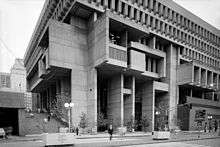Béton brut


Béton brut (French pronunciation: [betɔ̃ bʁy], raw concrete) is a smooth architectural surface made out of concrete. The concrete is left unfinished or roughly-finished after casting and it remains exposed visually. The final surface often shows the forms and structures of the formwork.[1]
History and characteristics
The use of béton brut was pioneered by Auguste Perret and other modern architects. It was used in such buildings as Unité d'Habitation in the early part of the twentieth century. It flourished as a part of the brutalist architecture of the 1960s and 70s. This largely gave way to structural expressionism as steel structures became more advanced and viable. Wood-imprinted concrete is still very popular in landscaping especially in some of the western European countries.
Exposed concrete surfaces can be varied with different formwork shetting (e.g. board shuttering, smooth formwork, form liner, form moulds, filter fleeces) or with surface processing techniques (e.g. washed concrete surfaces, photo concrete, acidified surfaces).[2]
Examples
- University of Illinois at Chicago (East side of campus designed by Walter Netsch of Skidmore, Owings & Merrill)
- The Evergreen State College
- Sainte-Bernadette-du-Banlay church, Nevers, France, architect Claude Parent
- Boston City Hall
- Royal National Theatre, London
- Unité d'Habitation
- Habitat 67
- the main branch of the Orange County Library System in Florida
- Dewan Tunku Cancelor at University of Malaya
- the Main Entrance to the War Memorial Complex, Brest Fortress
See also
References
- ↑ Exposed concrete. In: Weyer, Angela; Roig Picazo, Pilar; Pop, Daniel; Cassar, JoAnn; Özköse, Aysun; Vallet, Jean-Marc; Srša, Ivan, eds. (2015). EwaGlos. European Illustrated Glossary Of Conservation Terms For Wall Paintings And Architectural Surfaces. English Definitions with translations into Bulgarian, Croatian, French, German, Hungarian, Italian, Polish, Romanian, Spanish and Turkish. Petersberg: Michael Imhof. p. 46.
- ↑ Exposed concrete. In: Weyer, Angela; Roig Picazo, Pilar; Pop, Daniel; Cassar, JoAnn; Özköse, Aysun; Vallet, Jean-Marc; Srša, Ivan, eds. (2015). EwaGlos. European Illustrated Glossary Of Conservation Terms For Wall Paintings And Architectural Surfaces. English Definitions with translations into Bulgarian, Croatian, French, German, Hungarian, Italian, Polish, Romanian, Spanish and Turkish. Petersberg: Michael Imhof. p. 46.